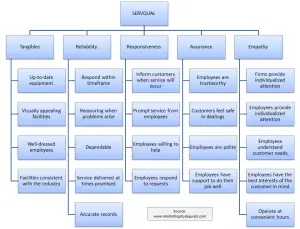List of SERVQUAL Questions
Below is a table (and a diagram at the bottom) containing the 22 questions originally used to construct the SERVQUAL model. There are several issues to note about the structure of the SERVQUAL questionnaire:
- About half the questions are posed as a negative question (as highlighted in the below table). This approach was used because it is a more appropriate research design for developing and validating scales,
- The questionnaire was split into two components. The first asked what level of service quality consumers expected from a firm in that service category (for example, banking, credit cards, repairs and maintenance and telephone companies) and then they asked the service quality of specific firms.

(Click to enlarge)
In the early stage of the development of SERVQUAL’s 22 questions, a much broader range of questions and factors were considered. Some of the additional factors included communication, courtesy, credibility, understanding customers, and access.
Through the research and validation process, it was determined that a smaller set of five dimensions was more reliable as a research tool.
As a result, a number of the above additional factors were aggregated into the dimensions of assurance and empathy.
SERVQUAL Questionnaire
| Main Factor | No. | Dimension/Question Area |
| Tangibles | 1 | Up-to-date equipment |
| 2 | Physical facilities are visually appealing | |
| 3 | Employees well-dressed/neat | |
| 4 | Appearance of the physical facilities are consistent with the type of service industry | |
| Reliability | 5 | The firm meets their promised time-frames for response |
| 6 | The firm is sympathetic and reassuring, when the customer has problems | |
| 7 | They are dependable | |
| 8 | They provide their services at the times promised | |
| 9 | They keep accurate records | |
| Responsiveness | 10 | They shouldn’t be expected to tell customers exactly when the service will be performed, negative |
| 11 | It is not reasonable to expect prompt service from employees, negative | |
| 12 | Employees do not always have to be willing to help customers, negative | |
| 13 | It’s OK to be too busy to respond promptly to customer requests, negative | |
| Assurance | 14 | Employees should be trustworthy |
| 15 | Customers should feel safe when transacting with employees | |
| 16 | Employees should be polite | |
| 17 | Employees should get adequate support from the firm to do their job well | |
| Empathy | 18 | Firms should not be expected to give each customer individualized attention, negative |
| 19 | Employees should not be expected to give each customer individualized attention, negative | |
| 20 | It is unrealistic to expect employees to fully understand the needs of the customer, negative | |
| 21 | It is unreasonable to expect employees to have the best interests of the customer at heart, negative | |
| 22 | Firms should not necessarily have to operate at hours convenient to all customers, negative |
You will note that some of the above questions have been framed as negative points (which have been indicated above as negative). This was part of the original research design and was undertaken is to help develop a more robust scale, rather than indicating consumer preferences. In each case (question), the firm would be generally looking to improve all aspects of their service quality.
In particular, the SERVQUAL model is designed to help service firms identify areas of service weakness in order to implement improvement strategies. Ideally, it also acts as an early warning system, as the model can be used to track service quality over time, providing long-term trends, performance benchmarks and the early identification of deterioration in specific service areas.
Related Topics
Understanding the SERVQUAL Model
Customer Satisfaction in Marketing
Academic Links
The original academic journal article discussing the construction of the SERVQUAL research instrument.
